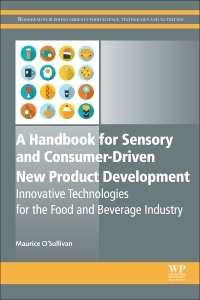Description
A Handbook for Sensory and Consumer-Driven New Product Development
Innovative Technologies for the Food and Beverage Industry
Woodhead Publishing Series in Food Science, Technology and Nutrition Series
Author: O'Sullivan Maurice
Language: English
Subject for A Handbook for Sensory and Consumer-Driven New Product...:
Keywords
2-AFC; 3-AFC; Acceptance; Active; Affective; Antioxidant; Approval; Aroma; Artificial sweetener; Beer; Beverage; Biscuits; Butter; Cakes; CATA; Cheese; Chemical; Chocolate; Coffee; Colour; Commercial; Commercialise; Confectionary; Consumer; Consumer-led; Contingency; Cream liqueur; Dairy; Descriptive; Difference tests; Duo-trio; External; Eye tracking; Fat; FCP; Flash; Flavour; Gluten; GPA; Hedonic; Immersive technology; Instrumental; Intelligent; Internal; Internet testing; Juice; LCF; Life; Mapping; Meat; Microbiological; Milk; Mimics; Mobile applications; Modified atmosphere packaging (MAP)Packaging; Modified; Muffins; Napping; Nitrite; Off-flavour; Online; Optimisation; Oxidation; Packaging; Paired comparison; Panellist; PCA; Phosphate; Physical; PLS; PLSR; Poultry; Powder; Preference; Processed; Profile; Profiling; QDA; Quality; Ranking; Rapid; Reduction; Regulation; Replacers; Risk; Salad dressings; Salt; Sauces; Sensory; Shelf life; Shelf; Soft drinks; Sorting; Spectrum; Spirits; Staling; Substitute; Sugar; TDS; Term reduction; Tetrad; Texture; Training; Triangle; Vacuum; Validation; Wine; Yoghurt
Support: Print on demand
Description
/li>Contents
/li>Biography
/li>Comment
/li>
A Handbook for Sensory and Consumer Driven New Product Development explores traditional and well established sensory methods (difference, descriptive and affective) as well as taking a novel approach to product development and the use of new methods and recent innovations. This book investigates the use of these established and new sensory methods, particularly hedonic methods coupled with descriptive methods (traditional and rapid), through multivariate data analytical interfaces in the process of optimizing food and beverage products effectively in a strategically defined manner.
The first part of the book covers the sensory methods which are used by sensory scientists and product developers, including established and new and innovative methods. The second section investigates the product development process and how the application of sensory analysis, instrumental methods and multivariate data analysis can improve new product development, including packaging optimization and shelf life. The final section defines the important sensory criteria and modalities of different food and beverage products including Dairy, Meat, Confectionary, Bakery, and Beverage (alcoholic and non-alcoholic), and presents case studies indicating how the methods described in the first two sections have been successfully and innovatively applied to these different foods and beverages.
The book is written to be of value to new product development researchers working in large corporations, SMEs (micro, small or medium-sized enterprises) as well as being accessible to the novice starting up their own business. The innovative technologies and methods described are less expensive than some more traditional practices and aim to be quick and effective in assisting products to market.
Sensory testing is critical for new product development/optimization, ingredient substitution and devising appropriate packaging and shelf life as well as comparing foods or beverages to competitor?s products.
Part I. Sensory Methods 1. Difference Methods 2. Descriptive Methods 3. Sensory Affective (Hedonic) Testing 4. Rapid Sensory Profiling Methods 5. Multivariate Data Analysis for Product Development and Optimisation
Part II. Product Quality, Development and Optimisation 6. Shelf Life and Sensory Quality of Foods and Beverages 7. Packaging Technologies for Maintaining Sensory Quality 8. Instrumental Assessment of the Sensory Quality of Food and Beverage Products 9. Nutritionally Optimised Low Fat Foods 10. Sensory and Consumer-Led Innovative Product Development – From Inception to the Shelf (Current and Future Methodologies)
Part III. Case Studies: Sensory and Consumer DrivenNPD in Action 11. Sensory Properties Affecting Meat and Poultry Quality 12. Sensory Properties of Dairy Products 13. Sensory Properties of Beverage Products (Alcoholic and Nonalcoholic) 14. Sensory Properties of Bakery and Confectionary Products
- Presents novel and effective sensory-based methods for new product development - two related fields that are often covered separately
- Provides accessible, useful guidance to the new product developer working in a large multi-national food company as well as novices starting up a new business
- Offers case studies that provide examples of how these methods have been applied to real product development by practitioners in a wide range of organizations
- Investigates how the application of sensory analysis can improve new product development including packaging optimization
These books may interest you

Sensory Evaluation Practices 122.46 €



